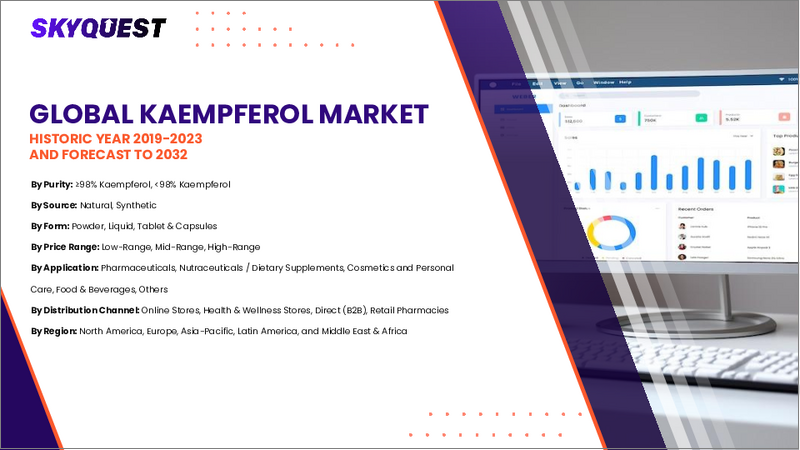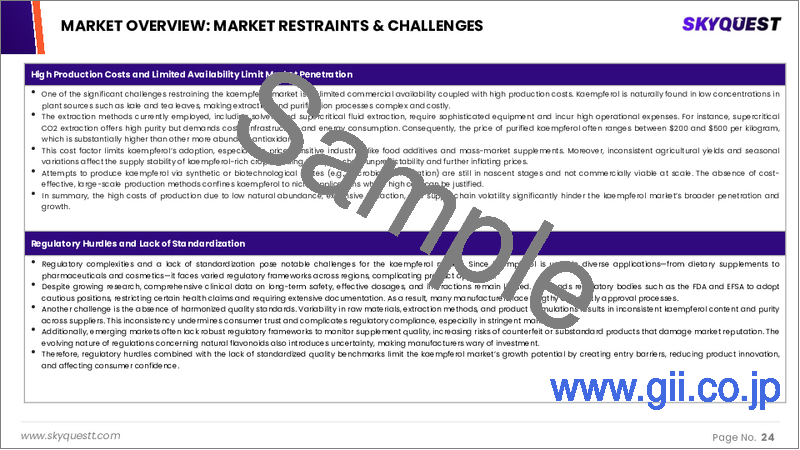|
|
市場調査レポート
商品コード
1673762
ケンペロールの市場規模、シェア、成長分析:純度別、用途別、供給源別、機能別、地域別 - 産業予測 2025~2032年Kaempferol Market Size, Share, and Growth Analysis, By Purity (10%, 20%), By Application (Dietary Supplements, Pharmaceuticals), By Source, By Function, By Region - Industry Forecast 2025-2032 |
||||||
|
|||||||
| ケンペロールの市場規模、シェア、成長分析:純度別、用途別、供給源別、機能別、地域別 - 産業予測 2025~2032年 |
|
出版日: 2025年03月01日
発行: SkyQuest
ページ情報: 英文 219 Pages
納期: 3~5営業日
|
全表示
- 概要
- 目次
ケンペロールの世界市場規模は2023年に48億米ドルと評価され、2024年の50億1,000万米ドルから2032年には70億7,000万米ドルに成長し、予測期間中(2025-2032年)にCAGR 4.4%で成長する見通しです。
お茶、ブロッコリー、ブドウなどの植物に含まれる天然フラボノイドであるケンペロールは、抗がん作用、心臓の健康増進、脳機能の強化、骨の健康強化など、その潜在的な健康効果が注目されています。酸化ストレスを軽減する能力を持つケンペロールは、抗菌作用、抗がん作用、抗糖尿病作用を示しながら、DNAや細胞の損傷を抑制することが期待されています。研究が進み、その特性が明らかになるにつれ、メーカー各社は天然物の代替品を探求する研究開発努力を強めており、市場成長を牽引しています。消費者は現在、オンラインショップや専門店など、多様な小売チャネルを通じてケンペロールを購入しています。FDA(米国食品医薬品局)やWHO(世界保健機関)などの規制当局による認可は、ケンペロールの安全性と有効性を強化するものであり、慢性疾患の予防に焦点を当てた成長中の栄養補助食品市場において、ケンペロールを重要な企業として位置づけています。
目次
イントロダクション
- 調査の目的
- 調査範囲
- 定義
調査手法
- 情報調達
- 二次と一次データの方法
- 市場規模予測
- 市場の前提条件と制限
エグゼクティブサマリー
- 世界市場の見通し
- 供給と需要の動向分析
- セグメント別機会分析
市場力学と見通し
- 市場概要
- 市場規模
- 市場力学
- 促進要因と機会
- 抑制要因と課題
- ポーターの分析
主な市場の考察
- 重要成功要因
- 競合の程度
- 主な投資機会
- 市場エコシステム
- 市場の魅力指数(2024年)
- PESTEL分析
- マクロ経済指標
- バリューチェーン分析
- 価格分析
ケンペロール市場規模:純度別 & CAGR(2025-2032)
- 市場概要
- 10%
- 20%
- 50%
- 95%
- 98%
ケンペロール市場規模:用途別& CAGR(2025-2032)
- 市場概要
- 栄養補助食品
- 医薬品
- 食品・飲料
- 化粧品
ケンペロール市場規模:供給源別& CAGR(2025-2032)
- 市場概要
- 天然分離株
- 合成化合物
- 植物エキス
ケンペロール市場規模:機能別& CAGR(2025-2032)
- 市場概要
- 抗酸化物質
- 抗炎症
- 抗がん剤
- 心臓保護
ケンペロール市場規模:地域別& CAGR(2025-2032)
- 北米
- 米国
- カナダ
- 欧州
- ドイツ
- スペイン
- フランス
- 英国
- イタリア
- その他欧州地域
- アジア太平洋地域
- 中国
- インド
- 日本
- 韓国
- その他アジア太平洋地域
- ラテンアメリカ
- ブラジル
- その他ラテンアメリカ地域
- 中東・アフリカ
- GCC諸国
- 南アフリカ
- その他中東・アフリカ
競合情報
- 上位5社の比較
- 主要企業の市場ポジショニング(2024年)
- 主な市場企業が採用した戦略
- 最近の市場動向
- 企業の市場シェア分析(2024年)
- 主要企業の企業プロファイル
- 企業の詳細
- 製品ポートフォリオ分析
- 企業のセグメント別シェア分析
- 収益の前年比比較(2022-2024)
主要企業プロファイル
- Shaanxi Pioneer Biotech Co., Ltd.(China)
- Xi'an Natural Field Bio-technique Co., Ltd.(China)
- Indena S.p.A.(Italy)
- Cayman Chemical(USA)
- Santa Cruz Biotechnology, Inc.(USA)
- Extrasynthese(France)
- Chengdu Biopurify Phytochemicals Ltd.(China)
- Nutra Green Biotechnology Co., Ltd.(China)
- Source Naturals(USA)
- NOW Foods(USA)
- Swanson Health Products(USA)
- Tianjin Jianfeng Natural Product R&D Co., Ltd.(China)
- Herbo Nutra(India)
- Botaniex Inc.(USA)
- Xian Yuensun Biological Technology Co., Ltd.(China)
- Zhejiang Fangge Pharmaceutical Co., Ltd.(China)
- Nanjing Zelang Medical Technology Co., Ltd.(China)
- Hunan Nutramax Inc.(China)
- Biopurify Phytochemicals Ltd.(China)
- Xi'an Sinuote Biotech Co., Ltd.(China)
結論と提言
Global Kaempferol Market size was valued at USD 4.8 billion in 2023 and is poised to grow from USD 5.01 billion in 2024 to USD 7.07 billion by 2032, growing at a CAGR of 4.4% during the forecast period (2025-2032).
Kaempferol, a natural flavonoid present in plants like tea, broccoli, and grapes, is garnering attention for its potential health benefits, including anticancer properties, improved heart health, enhanced brain function, and strengthened bone health. With its ability to reduce oxidative stress, kaempferol has shown promise in suppressing DNA and cell damage while displaying antimicrobial, anticancer, and antidiabetic activities. As research continues to unveil its properties, manufacturers are increasing R&D efforts to explore natural product alternatives, driving market growth. Consumers are now purchasing kaempferol through diverse retail channels, including online and specialty stores. Regulatory approval from entities like the FDA and the WHO reinforces its safety and efficacy, positioning kaempferol as a key player in the growing dietary supplement market focused on chronic disease prevention.
Top-down and bottom-up approaches were used to estimate and validate the size of the Global Kaempferol market and to estimate the size of various other dependent submarkets. The research methodology used to estimate the market size includes the following details: The key players in the market were identified through secondary research, and their market shares in the respective regions were determined through primary and secondary research. This entire procedure includes the study of the annual and financial reports of the top market players and extensive interviews for key insights from industry leaders such as CEOs, VPs, directors, and marketing executives. All percentage shares split, and breakdowns were determined using secondary sources and verified through Primary sources. All possible parameters that affect the markets covered in this research study have been accounted for, viewed in extensive detail, verified through primary research, and analyzed to get the final quantitative and qualitative data.
Global Kaempferol Market Segments Analysis
Global Kaempferol Market is segmented by Purity, Application, Source, Function and region. Based on Purity, the market is segmented into 10%, 20%, 50%, 95% and 98%. Based on Application, the market is segmented into Dietary Supplements, Pharmaceuticals, Food and Beverage and Cosmetics. Based on Source, the market is segmented into Natural Isolates, Synthetic Compounds and Plant Extracts. Based on Function, the market is segmented into Antioxidant, Anti-inflammatory, Anti-Cancer and Cardioprotective. Based on region, the market is segmented into North America, Europe, Asia Pacific, Latin America and Middle East & Africa.
Driver of the Global Kaempferol Market
A significant factor fueling the expansion of the global kaempferol market is the rising consumer preference for natural and organic products. As awareness of the health advantages associated with natural ingredients increases, many consumers are gravitating towards items that avoid synthetic additives and harmful chemicals. Kaempferol, a naturally occurring flavonoid present in numerous plant sources, is recognized as a safe and beneficial component in a variety of sectors, including dietary supplements, cosmetics, and functional foods. Consequently, the demand for kaempferol-enriched products is anticipated to rise in the forthcoming years, thereby propelling the growth of the kaempferol market.
Restraints in the Global Kaempferol Market
A significant limitation in the global kaempferol market is the elevated production costs, which render kaempferol-derived products comparatively pricey for consumers. The extraction of kaempferol from various plant sources can be both challenging and expensive due to the low yield of this compound. Furthermore, the manufacturing process necessitates specialized equipment and expertise, contributing to the overall increase in production expenses. This high cost can hinder the availability and accessibility of kaempferol products, posing a challenge to market growth. However, ongoing advancements in technology and innovative extraction methods may alleviate these costs, potentially making kaempferol-based products more affordable in the future.
Market Trends of the Global Kaempferol Market
The global kaempferol market is witnessing a notable trend driven by the rising consumer preference for natural and organic products. As health consciousness increases, consumers are leaning towards options that are devoid of synthetic chemicals, propelling kaempferol-a naturally occurring compound found in numerous plants-into the spotlight as a popular alternative to artificial antioxidants. This shift is further supported by its incorporation into the nutraceutical and functional food sectors, thanks to its potential health benefits such as antioxidant, anti-inflammatory, and anti-cancer properties. Additionally, intensified research and development efforts by manufacturers aim to innovate and enhance kaempferol-based offerings, positioning the market for robust growth in the coming years.
Table of Contents
Introduction
- Objectives of the Study
- Scope of the Report
- Definitions
Research Methodology
- Information Procurement
- Secondary & Primary Data Methods
- Market Size Estimation
- Market Assumptions & Limitations
Executive Summary
- Global Market Outlook
- Supply & Demand Trend Analysis
- Segmental Opportunity Analysis
Market Dynamics & Outlook
- Market Overview
- Market Size
- Market Dynamics
- Drivers & Opportunities
- Restraints & Challenges
- Porters Analysis
- Competitive rivalry
- Threat of substitute
- Bargaining power of buyers
- Threat of new entrants
- Bargaining power of suppliers
Key Market Insights
- Key Success Factors
- Degree of Competition
- Top Investment Pockets
- Market Ecosystem
- Market Attractiveness Index, 2024
- PESTEL Analysis
- Macro-Economic Indicators
- Value Chain Analysis
- Pricing Analysis
Global Kaempferol Market Size by Purity & CAGR (2025-2032)
- Market Overview
- 10%
- 20%
- 50%
- 95%
- 98%
Global Kaempferol Market Size by Application & CAGR (2025-2032)
- Market Overview
- Dietary Supplements
- Pharmaceuticals
- Food and Beverage
- Cosmetics
Global Kaempferol Market Size by Source & CAGR (2025-2032)
- Market Overview
- Natural Isolates
- Synthetic Compounds
- Plant Extracts
Global Kaempferol Market Size by Function & CAGR (2025-2032)
- Market Overview
- Antioxidant
- Anti-inflammatory
- Anti-Cancer
- Cardioprotective
Global Kaempferol Market Size & CAGR (2025-2032)
- North America (Purity, Application, Source, Function)
- US
- Canada
- Europe (Purity, Application, Source, Function)
- Germany
- Spain
- France
- UK
- Italy
- Rest of Europe
- Asia Pacific (Purity, Application, Source, Function)
- China
- India
- Japan
- South Korea
- Rest of Asia-Pacific
- Latin America (Purity, Application, Source, Function)
- Brazil
- Rest of Latin America
- Middle East & Africa (Purity, Application, Source, Function)
- GCC Countries
- South Africa
- Rest of Middle East & Africa
Competitive Intelligence
- Top 5 Player Comparison
- Market Positioning of Key Players, 2024
- Strategies Adopted by Key Market Players
- Recent Developments in the Market
- Company Market Share Analysis, 2024
- Company Profiles of All Key Players
- Company Details
- Product Portfolio Analysis
- Company's Segmental Share Analysis
- Revenue Y-O-Y Comparison (2022-2024)
Key Company Profiles
- Shaanxi Pioneer Biotech Co., Ltd. (China)
- Company Overview
- Business Segment Overview
- Financial Updates
- Key Developments
- Xi'an Natural Field Bio-technique Co., Ltd. (China)
- Company Overview
- Business Segment Overview
- Financial Updates
- Key Developments
- Indena S.p.A. (Italy)
- Company Overview
- Business Segment Overview
- Financial Updates
- Key Developments
- Cayman Chemical (USA)
- Company Overview
- Business Segment Overview
- Financial Updates
- Key Developments
- Santa Cruz Biotechnology, Inc. (USA)
- Company Overview
- Business Segment Overview
- Financial Updates
- Key Developments
- Extrasynthese (France)
- Company Overview
- Business Segment Overview
- Financial Updates
- Key Developments
- Chengdu Biopurify Phytochemicals Ltd. (China)
- Company Overview
- Business Segment Overview
- Financial Updates
- Key Developments
- Nutra Green Biotechnology Co., Ltd. (China)
- Company Overview
- Business Segment Overview
- Financial Updates
- Key Developments
- Source Naturals (USA)
- Company Overview
- Business Segment Overview
- Financial Updates
- Key Developments
- NOW Foods (USA)
- Company Overview
- Business Segment Overview
- Financial Updates
- Key Developments
- Swanson Health Products (USA)
- Company Overview
- Business Segment Overview
- Financial Updates
- Key Developments
- Tianjin Jianfeng Natural Product R&D Co., Ltd. (China)
- Company Overview
- Business Segment Overview
- Financial Updates
- Key Developments
- Herbo Nutra (India)
- Company Overview
- Business Segment Overview
- Financial Updates
- Key Developments
- Botaniex Inc. (USA)
- Company Overview
- Business Segment Overview
- Financial Updates
- Key Developments
- Xian Yuensun Biological Technology Co., Ltd. (China)
- Company Overview
- Business Segment Overview
- Financial Updates
- Key Developments
- Zhejiang Fangge Pharmaceutical Co., Ltd. (China)
- Company Overview
- Business Segment Overview
- Financial Updates
- Key Developments
- Nanjing Zelang Medical Technology Co., Ltd. (China)
- Company Overview
- Business Segment Overview
- Financial Updates
- Key Developments
- Hunan Nutramax Inc. (China)
- Company Overview
- Business Segment Overview
- Financial Updates
- Key Developments
- Biopurify Phytochemicals Ltd. (China)
- Company Overview
- Business Segment Overview
- Financial Updates
- Key Developments
- Xi'an Sinuote Biotech Co., Ltd. (China)
- Company Overview
- Business Segment Overview
- Financial Updates
- Key Developments





